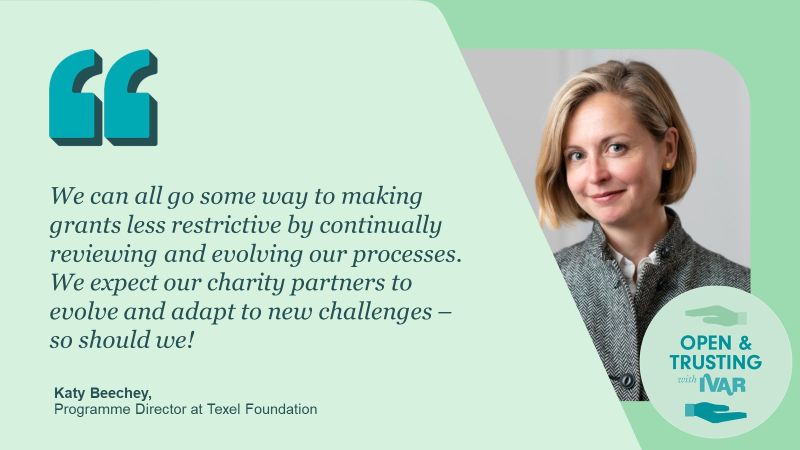
Texel Foundation is the independent, corporate foundation of the Texel Group (a global credit and political risk insurance broker). We give a significant percentage of net profits in grants to organisations around the world which promote the causes we care most about: health, education, social mobility and artistic opportunity.
As funders, we aspire to make a meaningful difference through the grants we offer to partners we trust. A question that underpins our decision-making at Texel Foundation is: ‘How can we do that most effectively?’. We have always been focused on building good relationships with organisations we believe in. We are a proactive funder in the sense that we approach charities we believe are a good fit for our charitable aims rather than having a lengthy, open application process. We found that offering our charity partners unrestricted funding helped to further establish a trusting relationship with them, and also helped us to see ourselves as part of something bigger.
We haven’t always offered unrestricted funding, but it has always been on our radar. From conversations with our partners, I heard that it was important to them, but not something many other funders offered at the time. This piqued my interest, and I started to seek out information: what are the benefits of unrestricted funding, and how were other funders doing it? I came across a report from IVAR called ‘The Holy Grail of Funding’. The evidence and examples in this report gave me the confidence to follow my instincts and propose a new strategy to our trustees.
One quote in particular really hit home: ‘We need to see ourselves in the long run, as investors rather than purchasers of outcomes.’ –Nigel Woof, Trustee of the William Grant Foundation
For us, as a corporate foundation, drawing comparisons to business investments helped to highlight the value and sense in offering unrestricted funding. I reminded our trustees that they would never buy a business then carve out core costs such as utilities or salaries; and the same is true for our grantgiving. It doesn’t make sense to cherry-pick if we believe in the potential and mission of the organisation as a whole. This was enough to convince our trustees to be very supportive of moving to unrestricted funding.
The benefit of offering unrestricted funding to our partners is clear. On one occasion, a charity leader cried when I told her that we would like to give them an unrestricted grant. And that reaction really struck a chord and stayed with me. I hadn’t realised what a relief it was to them to not have to think about the burden and anxiety around reporting and juggling project income. Our more open and trusting approach has also meant that we’re no longer requesting and reviewing reams of documentation just because we feel we ought to. We review what’s relevant, run the necessary checks and speak to those on the ground who are the experts. It’s more efficient and effective all around. Most importantly, it has led to us having a more balanced and equitable relationship with the organisations we fund, making us feel like a valued partner to them. We want our grantees to feel comfortable reaching out to us and sharing their challenges. We want them to feel empowered to make tough decisions, knowing that they have our trust and support. It is as much about the relationship as the grant itself
One of the reasons that some funders may be hesitant to offer unrestricted funding is fear of not being able to ‘measure impact’. As a funder, I understand your concern – we want to see clear evidence that the money we have given charities has made a difference. However, by reframing our understanding of impact, we can see that unrestricted funding doesn’t weaken impact – it strengthens it. Unrestricted funding allows us to zoom out and adopt a holistic approach to impact. Our dialogue switched from ‘Here’s an amazing pre-school we funded in rural Zambia’ to ‘This year we’ve supported this fantastic organisation and here are just some of the ways they’ve been making an impact’. You understand that you are part of a collective, bigger picture.
Another concern for some funders is the idea that unrestricted funding is riskier. Why? As funders, our role is to take on some degree of risk, which is why we do compliance and financial checks. This doesn’t have to change when offering unrestricted funding. If you trust a charity enough to give them money for a project, why wouldn’t you trust them with unrestricted funding? Either you believe in them and you trust them as an organisation, or you don’t.

Cambodian Children’s Trust is a charity that works to address the structural root causes of poverty by putting the power and control in the hands of the local communities to create a sustainable and scalable social protection system in Cambodia.
As a charity that works to address the structural root causes of poverty rather than react to its symptoms, sustainability is very important to us. Our aim isn’t to be in the community delivering essential services forever but for the local community to be empowered to control their own development without dependence on charity.
We want to ensure a lasting legacy in communities once we exit. The main struggle to achieving this is finding funders who are on board with how we operate: we are handing over control to local communities by ensuring essential social services operate out of public facilities.
Restricted funding often means we are limited in terms of how we can interact with the local community. For instance, many restricted grants will dictate that we can’t use local vendors as we can only get supplies from vetted suppliers. Unrestricted funding allows us to have more flexibility in where money is spent, which allows us to pass that flexibility on to the community so that, ultimately, they are the ones who are making the decisions.
This leads to innovative and sustainable work because the local community are invested in the outcomes. The flow-on effect of this approach is significant. It means that the projects grow organically in response to the real and unique needs of the communities. It means that the communities are not dependent on charities to operate their essential services so they are more likely to continue once the charity exits.
Restricted project funding has its place but is often a band-aid to a problem rather than addressing the root causes. It is often directed towards crisis response rather than preventing those crises from occurring in the first place. For example, restricted funding has helped us reunite children with their families but hasn’t provided funds to tackle the issues that have led to this separation in the first place. Changing the systems that create poverty isn’t fixed in a two-year funding cycle. We’ve often also been shouldered with the responsibility of continuing to support reunited families for several years after the restricted grant has ended because the family simply need more time and support to get back on their feet and prevent re-separation.
The innovative work of our Village Hive simply would never have come to be without the trust and generosity of unrestricted funding. We are very grateful to funders like Texel Foundation and the unrestricted funding we receive through public donations. Most of these donors have been on the journey with us for many years, believe in our mission and have enjoyed seeing the groundbreaking evolution that can come from sharing a unified vision and a belief in everyone’s ability to realise that vision.
When considering shifting to unrestricted funding, question your assumptions:
• Grants staff: question assumptions you make about your trustees – they may be more willing to shift than you think!
• Foundation trustees: question assumptions about how funds will be utilised – remember that charities are the experts in delivery.
• Charities: question assumptions that funders won’t be receptive – ask them if they would be willing to offer unrestricted funding and share with them how impactful that would be.
Have a look at what you want to achieve and ask yourself what type of funding allows you to achieve this. Often, funders will want to see long-lasting impact and sustainability. However, in reality what can be attributed to restricted funding is only outputs. NGOs spend time building trust and relationships with donors, as well as administration on reporting and donor communications.
Surely local communities are best informed on how to solve complex problems that impact them. For this to happen, the community really needs to be on board with what the charity is trying to do, and the best way to ensure sustainability is multi-year, unrestricted funding